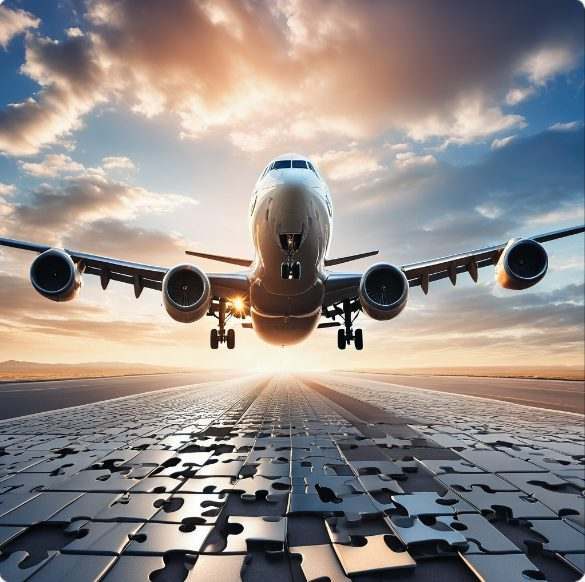Can we Solve the Transitioning Puzzle of Business Travel?
I travel for work and I feel (somewhat) guilty about it. I don’t feel so guilty that I refuse to travel and I like to think that I only travel when I really have to. I think that I travel when face-to-face is absolutely the only way things can be done. I always book economy. I care as much about my impact on the planet as being called out as a sustainability professional for not walking the talk. I know I’m not the only person who feels like this, but when I stand in a hub airport and watch the perpetual flow of passengers back and forth, I wonder whether I’m in a tiny minority… travel has certainly bounced back and I don’t see much evidence of concern.
So, my flights are co-shared between more airlines than before, nearly every flight is full, efficiencies have improved, and all that is good, but the volume is above 2019 levels and is projected to be 2-3 times higher by 2030. That’s not good, like really not good for the planet. Travel is also much less ‘fun’ than it used to be. Even the business-class pampering of a lucky upgrade has a sour taste, and the excuse the ‘travel and tourism saves’ sounds as hollow as a dead tree trunk. I’m stuck in a paradox, we all are, and it’s time we started taking a hard look at why.
The Necessity of International Business Travel
Let’s start with familiar territory. International business travel has been an essential component of global commerce for decades, things often don’t happen without face-to-face interactions and negotiations. In many industries, the personal touch and direct engagement with international partners, clients, and stakeholders are considered crucial for securing deals, resolving complex issues, and building trust. This need for physical presence often extends to trade shows, conferences, and industry events, where networking and knowledge exchange play pivotal roles in driving innovation and economic growth. In other words, as social beings, we need to connect with others and that means face-to-face, sometimes an online call just doesn’t cut it.
One of the ‘rubs’ is that business travel and personal travel use the same vehicles and infrastructure, and with unending travel growth, the stress and tiresomeness of the travel process only increases. Business travel has dealt with this by trying to separate itself to business class and lounges, sanctuaries for those with expense accounts and little conscience. Business travellers have even developed a chant, that their purpose is to create economic benefits where the pros outweigh the cons… the travel industry took up the same cry immediately, that ‘travel and tourism saves’… a mantra that is demonstrably false and morally corrupt, with the (very) tiny exception of responsible tourism from highly developed to less developed countries.
The Environmental Impact of Business Travel
The primary driver behind the shift to zero-GHG emissions for business travel is the urgent need to address climate change. Businesses are increasingly expected to align with global efforts to reduce GHG emissions. This shift is driven in part by growing consumer and investor demand for environmentally responsible practices. As a result, companies are under pressure to demonstrate their commitment to sustainability and environmental stewardship. However, the environmental impact of business travel, particularly air travel, cannot be overstated. Aviation is a significant contributor to global GHG emissions, with commercial flights releasing substantial amounts of GHGs and other pollutants into the atmosphere. The growth of international business travel thus raises concerns about the industry’s contribution to climate change, prompting calls for more sustainable practices and the reduction of unnecessary travel. Now we face the first puzzle; the demand that organisations transition to zero emissions versus the imperative to remain competitive and build new relationships to ensure business continuity. A second puzzle immediately rises as well, that to transition to net zero, we need new technologies to replace the enormous reliance on fossil-fuels in the aviation sector and that will require more travel. So, are we damned-if-we-do and damned-if-we-don’t?
The Path out of the Maze
Firstly, organisations must critically assess the necessity of each business trip, prioritising only those that truly require a physical presence. There is plenty of opportunity to leverage technology for virtual meetings, conferences, and negotiations that can significantly reduce the frequency of unnecessary travel while maintaining effective communication. This approach not only reduces GHG emissions but also optimises resources and time. However, we can’t rely solely on our staff to employ objective analysis to each business trip, we need a motivator – internal carbon costs. Just as interest, risk and cost of capital are included in budgeting and decision-making, so should internal carbon cost be included in procurement and expense accounts. The principle of ‘real cost’ must take environmental impacts into consideration. But this only delays the inevitable without further interventions.
What we really need to focus on is employee acceptance and behavioural change. Transitioning to zero GHG emissions for business travel requires a shift in mindset and habits. There are two aspects to this driver for change – firstly, organisations must stop the glorification of the ‘business class trip’ by encouraging employee decisions that actively minimise GHG emissions, and secondly, reward employees who adapt to new modes of transport, such as electric vehicles or public transport, and embrace a more sustainable approach to travel. Overcoming potential resistance and ensuring employee buy-in is essential for the success of GHG transitioning.
Travel Distance and Infrastructure Limitations
Businesses transitioning to zero GHG emissions for business travel must navigate a complex web of regulations and policies. Government incentives, subsidies, and emissions regulations can significantly impact the feasibility and cost-effectiveness of zero-emission travel solutions. Understanding and complying with these regulations while advocating for supportive policies is a critical aspect of the transition. However, the practicality of zero GHG emissions for long-distance business travel poses a challenge, especially in regions with limited infrastructure for electric or hydrogen vehicles. Businesses with operations spanning large geographical areas face the difficulty of ensuring zero-emission travel options across their entire operational footprint. Addressing these limitations requires strategic planning and investment in infrastructure development. So, each organisation needs to include risk and opportunity analysis to its approach to business travel and then decide appropriate boundaries. Let me give you an idea with the beginnings of business travel policy.
Business Travel Policy – For any form of transport or trip plan, the lowest emission option is chosen under the following conditions:
- For air travel, no flights are taken for distances of less than 1000km.
- For flight trips between 1000 – 3000kms, direct flights are chosen and the duration of stay in the destination is at least 10 days.
- For air travel of more than 3000kms, direct flights are chosen and the duration of stay is at least 14 days.
- Flights are only economy – no first or business class.
- Travellers stay at least 40% of the time in a sustainability-certified hotel / accommodation.
- No high carbon impact activities take place (helicopter flights, balloon rides, etc.)
- Food and waste are included in GHG emissions, and when meals are included (for example business dinners, events and conferences, etc) they should not include pork or beef.
- All car travel is by EV and recharging GHG emissions are reported.
- GHG emission are calculated for the full trip, reported transparently and included into the trip proposal.
- Residual GHG emissions are neutralised via reliable offset schemes and costs are included in the travel budget.
Public Perception and Brand Image
Let me just give you a moment to get over the shock of that policy recommendation. And now take a moment to consider that the transition to zero GHG emissions is closely tied to a company’s public perception and brand image. Businesses face the challenge of effectively communicating their commitment to sustainability while managing potential reputational risks (see more on greenwashing hazards here). This includes addressing any scepticism about green initiatives and ensuring that the transition aligns with the company’s broader values and messaging. A policy like the one above raises the bar and establishes a business as a doer, not a talker.
Taking the ‘sparkle’ out of business travel is critical to reducing impacts and your organisation’s transition plan. Educating employees about the benefits of zero-emission travel and providing training on new technologies and travel options are crucial for successful implementation as well as enhancing employee motivation and organisational commitment. Businesses must invest in employee awareness programs and training to promote understanding and acceptance of zero-emission travel solutions, and don’t be surprised if there is a strongly positive response, we all want to be working for a company that is seen to be doing the right thing.
So, Can we Solve the Transitioning Puzzle of Business Travel?
Sure, the transition to zero-GHG emissions organisation is a multifaceted challenge that requires technological, financial, behavioural, and regulatory considerations. Balancing the economic benefits of international engagement with the environmental consequences of frequent travel demands critical consideration and innovative solutions. While the journey to zero-GHG emissions may be complex, the potential benefits in terms of environmental impact, corporate responsibility, and public perception are hugely significant. By carefully navigating these issues, businesses can position themselves as leaders in sustainable practices while contributing to global efforts to combat climate change.
Moreover, dispelling the fallacy that travel and tourism saves can lead to a more nuanced understanding of the environmental impacts of international travel and the need for comprehensive strategies to mitigate negative effects. This puzzle is a tough one that requires some hard decisions and a shift away from old habits… none of that will be easy. But the potential outcomes of not doing so are far more serious and let’s face facts, if businesses don’t step up to the challenge, then the risk of external solutions being imposed whether they be regulatory, or via public opinion significantly increase. It’s time for the business travel community to start dancing to a new tune.





